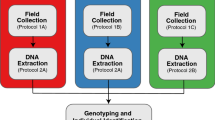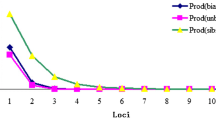Abstract
Extraction of DNA from non-invasive samples (feces) has been used increasingly in genetic research on wildlife. For effective and reliable genetic analyses, knowledge about which samples should be selected in the field is essential. For this reason, we examined the process of DNA degradation in feces of deer. We collected fresh fecal pellets from three wild deer living in a warm temperate forest. We then assessed the effects of time (3, 5, and 10 days) under three environmental conditions (on the forest floor, on exposed ground, and inside the laboratory) on the rates of correct genotyping (CG), amplification failure (NA), genotyping error among positive amplification (ER), false alleles (FA), and allelic dropout (AD) of 15 microsatellite loci. The rate of CG significantly decreased, and those of NA and FA increased with increasing lapse of time. Rates of CG tended to be highest and those of NA, ER, FA, and AD to be lowest in feces kept inside, followed by those on the forest floor. Suitability of samples for DNA extraction was lowest in fecal pellets left on exposed ground, and we suspect that rain may hasten DNA degradation. NA rate could serve as a reliable indicator of the quality of fecal pellets because it was significantly positively correlated with ER rate. For efficient genetic analyses using deer feces in warm temperate zones, we recommend collecting fecal pellets within 3 days of defecation, during periods without rainfall and from under the cover of trees.


Similar content being viewed by others
References
Agetsuma N, Agetsuma-Yanagihara Y, Hino T (2011) Food habits of Japanese deer in an evergreen forest: litter-feeding deer. Mamm Biol 76:201–207
Akomo-Okoue EF, Inoue E, Atteke C, Nakashima Y, Hongo S, Inoue-Murayama M, Yamagiwa J (2015) Noninvasive genetic analysis for assessing the abundance of duiker species among habitats in the tropical forest of Moukalaba, Gabon. Mammal Research 60:375–384
Barbosa MA, Carranza J (2010) Lack of geographic variation in Y-chromosomal introns of red deer (Cervus elaphus). Journal of Negative Results 7:1–4
Beja-Pereira A, Oliveira R, Alves PC, Schwartz MK, Luikart G (2009) Advancing ecological understandings through technological transformations in noninvasive genetics. Mol Ecol Resour 9:1279–1301
Bellemain E, Swenson JE, Tallmon D, Brunberg S, Taberlet P (2005) Estimating population size of elusive animals with DNA from hunter-collected feces: four methods for brown bears. Conserv Biol 19:150–161
Brinkman TJ, Schwartz MK, Person DK, Pilgrim KL, Hundertmark KJ (2010) Effects of time and rainfall on PCR success using DNA extracted from deer fecal pellets. Conserv Genet 11:1547–1552
Broquet T, Petit E (2004) Quantifying genotyping errors in noninvasive population genetics. Mol Ecol 13:3601–3608
Brownstein MJ, Carpten JD, Smith JR (1996) Modulation of non-templated nucleotide addition by Taq DNA polymerase: primer modifications that facilitate genotyping. BioTechniques 20:1004–1006
DeMay SM, Becker PA, Eidson CA, Rachlow JL, Johnson TR, Waits LP (2013) Evaluating DNA degradation rates in faecal pellets of the endangered pygmy rabbit. Mol Ecol Res 13:654–662
Flagstad O, Roed K, Stacy JE, Jakobsen KS (1999) Reliable noninvasive genotyping based on excremental PCR of nuclear DNA purified with a magnetic bead protocol. Mol Ecol 8:879–883
Hajkova P, Zemanova B, Bryja J, Hajek B, Roche K, Tkadlec E, Zima J (2006) Factors affecting success of PCR amplification of microsatellite loci from otter faeces. Mol Ecol Notes 6:559–562
Hayaishi S, Kawamoto Y (2006) Low genetic diversity and biased distribution of mitochondrial DNA haplotypes in the Japanese macaque (Macaca fuscata yakui) on Yakushima Island. Primates 47:158–164
Henry-Roitberg C (2008) The phylogeography of red deer (Cervus elaphus) in Exmoor National Park. University of Edinburgh, Edinburgh
Inoue E (2015) DNA analysis using noninvasive samples: methods of sample collection, DNA extraction, PCR amplification and kinship analysis. Primate Research 31:3–18 (in Japanese)
Inoue E, Akomo-Okoue EF, Ando C, Iwata Y, Judai M, Fujita S, Hongo S, Nze-Nkogue C, Inoue-Murayama M, Yamagiwa J (2013) Male genetic structure and paternity in western lowland gorillas (Gorilla gorilla gorilla). Am J Phys Anthropol 151:583–588
Inoue E, Inoue-Murayama M, Vigilant L, Takenaka O, Nishida T (2008) Relatedness in wild chimpanzees: influence of paternity, male philopatry, and demographic factors. Am J Phys Anthropol 137:256–262
Kohn MH, Wayne RK (1997) Facts from feces revisited. Trends Ecol Evol 12:223–227
Lampa S, Henle K, Klenke R, Hoehn M, Gruber B (2013) How to overcome genotyping errors in non-invasive genetic mark-recapture population size estimation—a review of available methods illustrated by a case study. J Wildl Manag 77:1490–1511
Longmire JL, Maltbie M, Baker RJ (1997) Use of "lysis buffer" in DNA isolation and its implication for museum collections. Museum of Texas Tech University, Lubbock
Lucchini V, Fabbri E, Marucco F, Ricci S, Boitani L, Randi E (2002) Noninvasive molecular tracking of colonizing wolf (Canis lupus) packs in the western Italian Alps. Mol Ecol 11:857–868
Morin PA, Chambers KE, Boesch C, Vigilant L (2001) Quantitative polymerase chain reaction analysis of DNA from noninvasive samples for accurate microsatellite genotyping of wild chimpanzees (Pan troglodytes versus). Mol Ecol 10:1835–1844
Murphy MA, Kendall KC, Robinson A, Waits LP (2007) The impact of time and field conditions on brown bear (Ursus arctos) faecal DNA amplification. Conserv Genet 8:1219–1224
Okada A, Tamate HB (2000) Pedigree analysis of the sika deer (Cervus nippon) using microsatellite markers. Zool Sci 17:335–340
Pérez-Espona S, Pérez-Barbería FJ, Goodall-Copestake WP, Jiggins CD, Gordon IJ, Pemberton JM (2009) Genetic diversity and population structure of Scottish Highland red deer (Cervus elaphus) populations: a mitochondrial survey. Heredity 102:199–210
Piggott MP (2004) Effect of sample age and season of collection on the reliability of microsatellite genotyping of faecal DNA. Wildl Res 31:485–493
R Core Team (2015) R: a language and environment for statistical computing (ver3.2.0). R Foundation for Statistical Computing, Vienna
Renan S, Speyer E, Shahar N, Gueta T, Templeton AR, Bar-David S (2012) A factorial design experiment as a pilot study for noninvasive genetic sampling. Mol Ecol Resour 12:1040–1047
Schettler E, Steinbach F, Eschenbacher-Kaps I, Gerst K, Meussdoerffer F, Risch K, Streich WJ, Frölich K (2006) Surveillance for prion disease in Cervids, Germany. Emerg Infect Dis 12:319–322
Skaug H, Fournier D, Bolker B, Magnusson A, Nielsen A (2014) Generalized linear mixed models using AD model builder. version 0.8.0. http://glmmadmb.r-forge.r-project.org. Accessed 23 May 2014
Taberlet P, Griffin S, Goossens B, Questiau S, Manceau V, Escaravage N, Waits LP, Bouvet J (1996) Reliable genotyping of samples with very low DNA quantities using PCR. Nucleic Acids Res 24:3189–3194
Tagawa H (1980) Vegetation on the western slope of Mt. Kuniwaridake, Yakushima Island. Science Reports of Kagoshima University 29:121–137 (in Japanese)
Tagawa H (1994) Natural World Heritage, Yakushima. Japan Broadcast Publishing, Tokyo (in Japanese)
Tamate HB, Okada A, Minami M, Ohnishi N, Higuchi H, Takatsuki S (2000) Genetic variations revealed by microsatellite markers in a small population of the sika deer (Cervus nippon) on Kinkazan Island, northern Japan. Zool Sci 17:47–53
Tamate HB, Tatsuzawa S, Suda K, Izawa M, Doi T, Sunagawa K, Miyahira F, Tado H (1998) Mitochondrial DNA variations in local populations of the Japanese sika deer, Cervus nippon. J Mammal 79:1396–1403
Tsujino R, Yumoto T (2004) Effects of sika deer on tree seedlings in a warm temperate forest on Yakushima Island, Japan. Ecol Res 19:291–300
Wedrowicz F, Karsa M, Mosse J, Hogan FE (2013) Reliable genotyping of the koala (Phascolarctos cinereus) using DNA isolated from a single faecal pellet. Mol Ecol Resour 13:634–641
Wehausen JD, Ramey RR, Epps CW (2004) Experiments in DNA extraction and PCR amplification from bighorn sheep feces: the importance of DNA extraction method. J Hered 95:503–509
Whitehead GK (1993) Whitehead encyclopedia of deer. Swan Hill Press, Shrewsbury
Woodruff SP, Johnson TR, Waits LP (2015) Evaluating the interaction of faecal pellet deposition rates and DNA degradation rates to optimize sampling design for DNA-based mark-recapture analysis of Sonoran pronghorn. Mol Ecol Resour 15:843–854
Yamada M, Hosoi E, Nagata J, Tamate HB, Tado H (2007) Phylogenetic relationship of the southern Japan lineages of the sika deer (Cervus nippon) in Shikoku and Kyushu Islands, Japan. Mammal Study 32:121–127
Yuasa T (2007) Genetic structure and gene flow between the Japanese sika deer populations in Tanzawa Mountains and Mt. Fuji area. In: Institution of scientific investigation on Tanzawa-Oyama (ed) Reports of scientific investigation on Tanzawa-Oyama. Hiraoka Environmental Science Laboratory, Sagamihara, pp146–152 (in Japanese)
Yuasa T, Nagata J, Hamasaki S, Tsuruga H, Furubayashi K (2007) The impact of habitat fragmentation on genetic structure of the Japanese sika deer (Cervus nippon) in southern Kantoh, revealed by mitochondrial D-loop sequences. Ecol Res 22:97–106
Acknowledgments
Funding was provided by the Leading Graduate Program in Primatology and Wildlife Science, Kyoto University, Japan, as part of the Resilience and Adaptation Program. We thank participants of the programs: B. Z. Katale, E. L. Baking, H. Koba, K. Ichiyama, N. Tajima, and T. Ohkawa for analyses; Dr. H. Sugiura, Dr. K. Agata, Dr. T. Matsuzawa, H. Tajima, K. Yokoyama, and other staff of Kyoto University for supporting this research. We are grateful to the Ministry of the Environment, the Yakushima Forest Environment Conservation Center, and Kagoshima Prefecture for permitting us to conduct this research.
Author information
Authors and Affiliations
Corresponding author
Additional information
Communicated by: Cino Pertoldi
Rights and permissions
About this article
Cite this article
Agetsuma-Yanagihara, Y., Inoue, E. & Agetsuma, N. Effects of time and environmental conditions on the quality of DNA extracted from fecal samples for genotyping of wild deer in a warm temperate broad-leaved forest. Mamm Res 62, 201–207 (2017). https://doi.org/10.1007/s13364-016-0305-x
Received:
Accepted:
Published:
Issue Date:
DOI: https://doi.org/10.1007/s13364-016-0305-x




